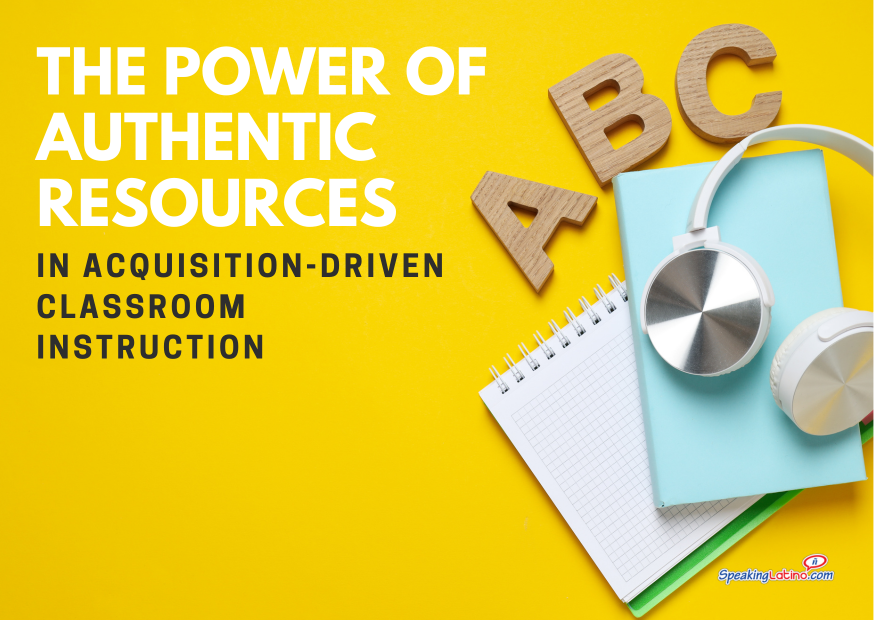
The content of this article is based on the presentation, Integrating #authres in an ADI Classroom by Haylee Ziegler, which was part of the World Language Teacher Summit.
The Role of Authentic Resources in Contemporary Instruction
In contemporary foreign language instruction, what truly defines an effective learning environment is its ability to emulate real-world scenarios and experiences for students. As language educators grapple with the challenge of simulating authentic communicative contexts, the integration of authentic resources into the classroom has increasingly been recognized for its invaluable contribution.
We'll explain the essence and strategy behind embedding authentic resources with a focus on Acquisition-Driven Instruction (ADI) classrooms.
Defining Authentic Resources and Their Role in ADI
The term "authentic resource" refers to materials created by and for native speakers, including multimedia, texts, visuals, and realia intended for daily communication rather than teaching. These resources are instrumental in exposing students not only to the target language but also to its vibrant cultural fabric. Acquisition-Driven Instruction (ADI) classrooms emphasize natural language acquisition over rote learning, drawing on the principle that language is best acquired through meaningful communication rather than explicit grammatical instruction.
Integrating authentic resources within ADI pedagogy champions a naturalistic route to language learning, mirroring the process young children undergo when acquiring their first language. It revolves around 'comprehensible input' — the exposure to language just beyond the current proficiency of learners, which is crucial for language acquisition. Authentic resources complement this by offering fresh, culturally relevant input that sparks learners' curiosity and motivation.
Utilizing Authentic Resources for Comprehensibility
It is vital to scaffold the use of authentic resources to align with learners’ proficiency levels and to make input comprehensible. Scaffolding may involve providing keyword lists, visual aids, or resorting to shared language explanations to ensure students grasp the content's essence. For novice learners, recognizing keywords and main ideas in authentic materials is a pivotal skill that facilitates deeper comprehension and subsequent language acquisition.
Interpretive Comprehension Tasks in Novice Classrooms
In aligning with ACTFL's interpretive task structure, incorporating literal and interpretive comprehension tasks into lessons provides a balanced approach for student engagement. Novice learners benefit greatly from interpretive tasks that challenge them to infer meaning from context. Such activities aid in developing critical language skills like prediction, summarization, and questioning—all critical cognitive skills in language acquisition.
Strategies for Incorporating Authentic Resources in the Classroom: Engaging Students with Visuals and Predictions
A successful way to immerse learners is to present authentic resources, such as images and memes, to hook their attention. This can involve picture talks where students predict or narrate possible backstories and contexts, engaging their interpretive skills and creativity. This method leverages the visual appeal of authentic resources to spark interest and promote language practice in range from beginners to advanced learners.
Incorporation in Routine Class Activities
Using authentic resources, like weather forecasts or images from Spanish-speaking countries, as part of daily warm-up activities, familiarizes students with the regularity and variety of language use. This method promotes an understanding of everyday communication within diverse linguistic cultures.
Adapting Resources for Different Proficiency levels
One resource can serve diverse proficiency levels by altering the complexity of associated tasks. For example, while beginners might identify keywords or main ideas, advanced learners might analyze subtleties or cultural nuances presented in the same resource.
Leveraging Social Media for Real-life Contexts
Modern learners resonate with content from platforms like Instagram or YouTube. Utilizing social media, such as outfits of the day (OOTD) or travel vlogs, authenticates the learning process. This strategy involves learners by inviting them to create questions, narrations, or event sequencing from these videos, thus personalizing their learning experience.
Enhancing with MovieTalk and Commercials
MovieTalk, a technique developed by Dr. Ashley Hastings, and the use of commercials serve as effective tools for language acquisition. They present engaging scripts, visuals, and contexts that motivate learners to listen attentively, practice writing, perform acting, and apply inferencing, thereby enhancing the language acquisition process holistically.
Scaffolding Authentic Texts
The use of authentic text resources can be scaffolded by rewriting news articles, providing word banks, graphic organizers, and relevant images. Pre-teaching vocabulary supports learners in their comprehension. This is particularly effective in allowing learners to engage with complex texts without being overwhelmed.
Teaching with Infographics
Infographics offer a visual and informative approach to complex text engagement. They idealize the use of keyword recognition, main idea detection, and organizational understanding. Infographics can be broken down to manageable portions, ensuring students can fully engage with the material without being burdened by its complexity.
Shared Language for Relatable Inquiry
Asking questions about authentic resources using shared language helps novice learners comprehend without facing language barriers. This approach recognizes the developmental stage of the learners and provides them with the necessary support to enhance understanding.

Acquisition-Driven Instruction (ADI) classrooms emphasize natural language acquisition over rote learning
Culture-embedded Readers and Novels
Incorporating culture-embedded readers and novels in language instruction promotes cultural literacy. Using maps and cultural materials that complement the content engages students not only linguistically but also contextually within the cultural narrative.
Finding and Utilizing Authentic Resources
It is essential to utilize contemporary resources that resonate with learners' interests and global perspective. Resource curation through platforms such as Pinterest broadens accessibility to authentic resources. Educators could share tips on resource compilation, highlighting avenues like Pinterest pages dedicated to language instruction.
Supporting Educators
Professional development opportunities provided by organizations such as Calico Spanish support educators in the integration of authentic resources. These initiatives offer live sessions and free resources, aiding teachers in effectively utilizing authentic resources to foster acquisition-driven learning environments.
FAQs About Authentic Resources
What are some examples of authentic resources that can be integrated into a Spanish classroom?
Authentic resources play a crucial role in enhancing language learning and cultural understanding in a Spanish classroom. Here are some examples of authentic resources that can be integrated:
- Actual People: Inviting native speakers or individuals from the target culture to interact with students in the classroom.
- TV Programs and Radio Broadcasts: Utilizing authentic media content such as TV shows, radio programs, and commercials to expose students to real-life language use.
- Debates and Interviews: Incorporating authentic conversations, debates, and interviews to provide students with genuine language contexts.
- Cultural Artifacts: Using items like museum brochures, restaurant menus, and photos to explore cultural aspects related to the target language.
- Authentic Texts: Including authentic texts like newspapers, magazines, and literature written in the target language to expose students to diverse language styles and vocabulary.
These resources not only make language learning more engaging but also help students develop cultural competence and real-world language skills .
How can authentic resources benefit students in an ADI classroom?
Authentic resources offer numerous benefits to students in an Acquisition-Driven Instruction (ADI) classroom:
- Real-Life Language Use: Authentic resources provide students with exposure to how the language is used in real-life situations, helping them grasp authentic language patterns and expressions .
- Cultural Immersion: By incorporating authentic resources, students can delve deeper into the cultural products, practices, and perspectives of the target language community, fostering a more profound understanding of the culture .
- Enhanced Engagement: Using authentic materials like songs, biographies, and multimedia content can increase student engagement and motivation in the learning process .
- Language Proficiency: Exposure to authentic resources helps students develop their language proficiency by challenging them to interpret and analyze real-world texts, preparing them for communication in authentic contexts .
- Contextual Learning: Authentic resources provide rich cultural contexts that aid in language comprehension and retention, making learning more meaningful and memorable for students .
By integrating authentic resources into the ADI classroom, educators can create a dynamic and immersive language learning environment that promotes linguistic and cultural competence among students.

Commercials are effective tools for language acquisition
What are some practical strategies for incorporating authentic resources into lesson plans?
Incorporating authentic resources into lesson plans can greatly enhance language learning experiences. Here are some practical strategies for integrating authentic resources into your classroom:
- Hook Learners: Use authentic resources to capture students' interest and engage them at the beginning of a lesson or unit. Conduct activities like picture talks, predictions based on images or videos, and sentence frame exercises to introduce the resource .
- Recycle Resources: Revisit authentic resources throughout the unit to deepen students' understanding of the cultural context embedded in the material. Encourage students to explore different aspects of the authentic resource as they progress through the unit .
- Variety of Activities: Incorporate authentic resources in various activities such as songs, biographies, calendar talks, weather chats, and warm-up exercises to expose students to different types of language use and cultural content .
- Utilize Different Types of Authentic Resources: Explore a range of authentic resources including TV programs, radio broadcasts, debates, interviews, and cultural artifacts to provide diverse language contexts and cultural insights to students .
- Adaptation and Focus: Adapt authentic resources to make them comprehensible for students by focusing on key language structures and cultural elements. Remember that students do not need to understand every word in an authentic resource for it to be beneficial .
By incorporating these strategies, educators can effectively integrate authentic resources into their lesson plans, creating a dynamic and culturally rich learning environment for students in the ADI classroom.
Leveraging Authentic Resources in Language Education
The strategic use of authentic resources is an indispensable part of effective language instruction that aspires to mirror real-world engagement with the target language and culture. As educators, the deliberate and skilled application of authentic resources within ADI pedagogy reinforces a comprehensive learning experience that transcends traditional language learning boundaries. Through scaffolded interactive tasks and the adept use of various forms of authentic resources, language educators can nurture a classroom atmosphere enriched with vivid cultural and linguistic authenticity, ultimately contributing to students' language proficiency and cultural competence.